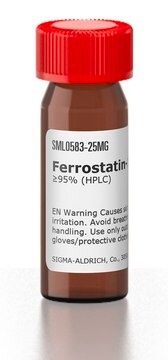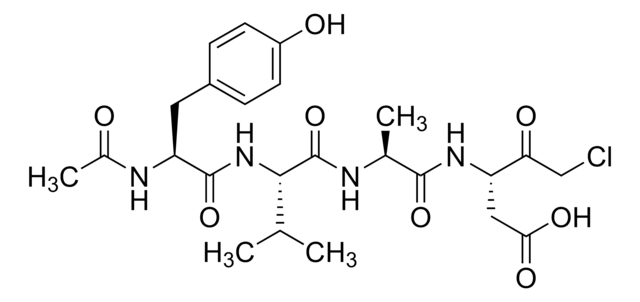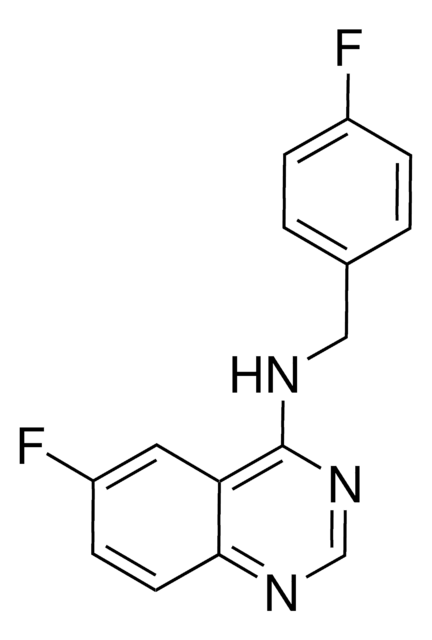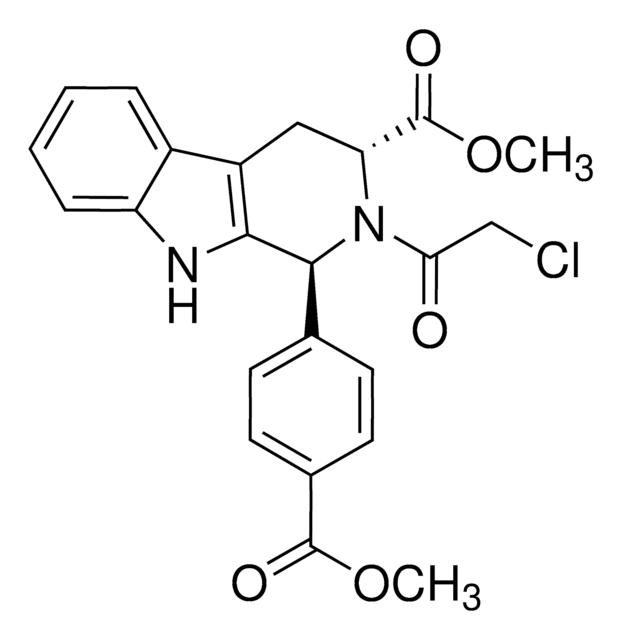SML0063
Q-VD-OPh hydrate
≥95% (HPLC), powder, pan-caspase inhibitor
Sinónimos:
5-(2,6-Difluorophenoxy)-3-[[3-methyl-1-oxo-2-[(2-quinolinylcarbonyl)amino]butyl]amino]-4-oxo-pentanoic acid hydrate
About This Item
Productos recomendados
Nombre del producto
Q-VD-OPh hydrate, ≥95% (HPLC)
assay
≥95% (HPLC)
form
powder
storage condition
desiccated
color
white to light brown
solubility
DMSO: ≥14 mg/mL
shipped in
wet ice
storage temp.
−20°C
SMILES string
O=C(NC(C(C)C)C(NC(C(COC1=C(F)C=CC=C1F)=O)CC(O)=O)=O)C2=NC3=CC=CC=C3C=C2.[H]O[H]
InChI
1S/C26H25F2N3O6.H2O/c1-14(2)23(31-25(35)19-11-10-15-6-3-4-9-18(15)29-19)26(36)30-20(12-22(33)34)21(32)13-37-24-16(27)7-5-8-17(24)28;/h3-11,14,20,23H,12-13H2,1-2H3,(H,30,36)(H,31,35)(H,33,34);1H2/t20-,23-;/m0./s1
InChI key
ONOTWLLTFZMERH-WCRWPNQISA-N
Application
- as a pan-caspase inhibitor to prevent cell death in urothelial carcinoma cells (UCC)
- to induce canonical caspase-dependent apoptosis in UC cells
- to block caspase-3 and Poly (ADP-ribose) polymerase-1 (PARP-1)
- to study the protective role of EspZ effector protein against apoptosis and necrosis in human epithelial cells
Biochem/physiol Actions
Features and Benefits
Storage Class
11 - Combustible Solids
wgk_germany
WGK 3
flash_point_f
Not applicable
flash_point_c
Not applicable
Elija entre una de las versiones más recientes:
¿Ya tiene este producto?
Encuentre la documentación para los productos que ha comprado recientemente en la Biblioteca de documentos.
Los clientes también vieron
Artículos
We offers many products related to caspases for your research needs.
Contenido relacionado
n proliferating cells, the cell cycle consists of four phases. Gap 1 (G1) is the interval between mitosis and DNA replication that is characterized by cell growth. Replication of DNA occurs during the synthesis (S) phase, which is followed by a second gap phase (G2) during which growth and preparation for cell division occurs. Together, these three stages comprise the interphase phase of the cell cycle. Interphase is followed by the mitotic (M) phase.
Apoptosis, or programmed cell death (PCD), is a selective process for the removal of unnecessary, infected or transformed cells in various biological systems. As it plays a role in the homeostasis of multicellular organisms, apoptosis is tightly regulated through two principal pathways by a number of regulatory and effector molecules.
Nuestro equipo de científicos tiene experiencia en todas las áreas de investigación: Ciencias de la vida, Ciencia de los materiales, Síntesis química, Cromatografía, Analítica y muchas otras.
Póngase en contacto con el Servicio técnico












